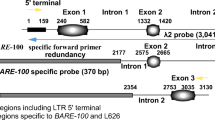Abstract
Genetic and physical analyses have demonstrated an intimate interaction or pairing of homologous chromosomes in the nuclei of manyDrosophila cell types. Experiments were performed to determine whether P elements transposing from a given chromosome to its homolog would preferentially insert in the region corresponding to the donor site, perhaps due to such a proximity. AP[lacZ;ry +] element at thecactus locus (35F) on the second chromosome was mobilized and 96 insertions on the homolog were recovered. The distribution of these new insertions was determined by recombination mapping and molecular analysis, and compared with a control set of 93 second-chromosome insertions originating from theX chromosome. A nearly threefold preference was observed for re-insertion in a region of two to three number divisions aroundcactus on the homolog. However, none of these “local” insertions was actually within ∼ 50 kb of the site atcactus corresponding to the starting site. This is in marked contrast to the previously described phenomenon of intrachromosomal local transposition, where the majority of local transpositions are within 10 kb. The data suggest that the mechanisms for intrachromosomal and interchromosomal local transposition are distinct, and are consistent with a model for interchromosomal local transposition involving proximity of homologous chromosomal regions in the nuclei of the germline cells.
Similar content being viewed by others
References
Ashburner M (1990)Drosophila: A laboratory handbook. Cold Spring Harbor Laboratory Press, New York
Ashburner M (1991)Drosophila genetic map. Dros Inf Ser 69:211–277
Ashburner M, Tsubota S, Woodruff RC (1982) The genetics of a small chromosome region ofDrosophila melanogaster containing the structural gene for alcohol dehydrogenase. IV: Scutoid, an antimorphic mutation. Genetics 102:401–420
Berg CA, Spradling AC (1991) Studies on the rate and site-specificity of P element transposition. Genetics 127:515–524
Bownes M (1990) Preferential insertion of P elements into genes expressed in the germ-line ofDrosophila melanogaster. Mol Gen Genet 222:457–460
Cooley LR, Kelley R, Spradling A (1988) Insertional mutagenesis of theDrosophila genome with single P elements. Science 239:1121–1128
Daniels SB, Chovnick A (1993) P element transposition inDrosophila melanogaster: an analysis of sister-chromatid pairs and the formation of intragenic secondary insertions during meiosis. Genetics 133:623–636
Engels W (1989) P elements inDrosophila melanogaster. In: Berg D, Howe M (eds) Mobile DNA. American Society for Microbiology, Washington, DC, pp 437–484
Engels WR, Johnson-Schlitz DM, Eggleston WB, Sved J (1990) High frequency P element loss inDrosophila is homolog dependent. Cell 62:515–525
Fauvarque M-O, Dura J-M (1993)polyhomeotic regulatory sequences induce developmental regulator-dependent variegation and targeted P-element insertions inDrosophila. Genes Dev 7:1508–1520
Gloor GB, Nassif NA, Johnson-Schlitz DM, Preston CR, Engels WR (1991) Targeted gene replacement inDrosophila via P element-induced gap repair. Science 253:1110–1117
Hama C, Ali Z, Kornberg T (1990) Region specific recombination and expression are directed by portions of theDrosophila engrailed promoter. Genes Dev 4:1079–1093
Hiraoka Y, Dernburg AF, Parmelee SJ, Rykowski MC, Agard DA (1993) The onset of homologous chromosome pairing duringDrosophila melanogaster embryogenesis. J Cell Biol 120:591–600
Karpen GH, Spradling AC (1992) Analysis of subtelomeric heterochromatin in theDrosophila minichromosomeDp1187 by single P element insertional mutagenesis. Genetics 132:737–753
Kassis JA, Noll E, VanSickle EP, Odenwald WF, Perrimon N (1992) Altering the insertional specificity of aDrosophila transposable element. Proc Natl Acad Sci USA 89:1919–1923
Kaufman PD, Rio DC (1992) P element transposition in vitro proceeds by a cut-and-paste mechanism and uses GTP as a cofactor. Cell 69:27–39
Lewis EB (1954) The theory and application of a new method of detecting chromosomal rearrangements inDrosophila melanogaster. Am Nat 88:225–239
Lifschytz E, Hareven D (1982) Heterochromatin markers: arrangement of obligatory heterochromatin, histone genes and multigene families in the interphase nucleus ofD. melanogaster. Chromosoma 6:443–455
Lindsley DL, Zimm GG (1992) The genome ofDrosophila melanogaster. Academic Press, New York
Mlodzik M, Hiromi Y (1992) The enhancer trap method inDrosophila: its application to neurobiology. In: Cann PM (ed) Gene expression in neural tissues. (Methods in neuroscience 9) Academic Press, Orlando, Florida, pp 397–414
Rio DC (1990) Molecular mechanisms regulatingDrosophila P element transposition. Annu Rev Genet 24:543–578
Robertson HM, Preston CR, Phillis RW, Johnson-Schlitz D, Benz WK, Engels WR (1988) A stable genomic source of P element transposase inDrosophila. Genetics 118:461–470
Roth S, Hiromi Y, Godt D, Nusslein-Volhard C (1991)cactus, a maternal gene required for proper formation of the dorsoventral morphogen gradient inDrosophila embryos. Development 112:371–388
Sambrook J, Fritsch EF, Maniatis T (1989) Molecular cloning: a laboratory manual, second edition. Cold Spring Harbor Laboratory Press, Cold Spring Harbor, New York
Strickberger MW (1976) Genetics, second edition. Macmillan, New York, pp 140–163
Sved JA, Eggleston WB, Engels WR (1990) Germ-line and somatic recombination induced by in vitro modified P elements inDrosophila melanogaster. Genetics 124:331–337
Tower J, Karpen GH, Craig N, Spradling AC (1993) Preferential transposition ofDrosophila P elements to nearby chromosomal sites. Genetics 133:347–359
Wu C-T, Goldberg ML (1989) TheDrosophila zeste gene and transvection. Trends Genet 5:189–194
Zhang P, Spradling AC (1993) Efficient and dispersed local P element transposition fromDrosophila females. Genetics 133:361–373
Author information
Authors and Affiliations
Additional information
Communicated by M. Ashburner
Rights and permissions
About this article
Cite this article
Tower, J., Kurapati, R. Preferential transposition of aDrosophila P element to the corresponding region of the homologous chromosome. Molec. Gen. Genet. 244, 484–490 (1994). https://doi.org/10.1007/BF00583899
Received:
Accepted:
Issue Date:
DOI: https://doi.org/10.1007/BF00583899




